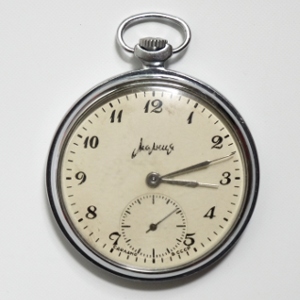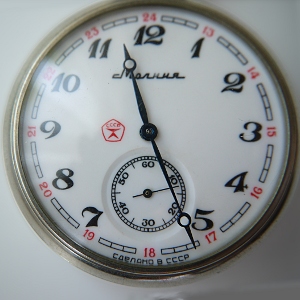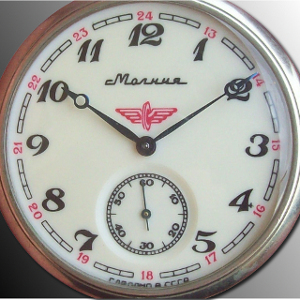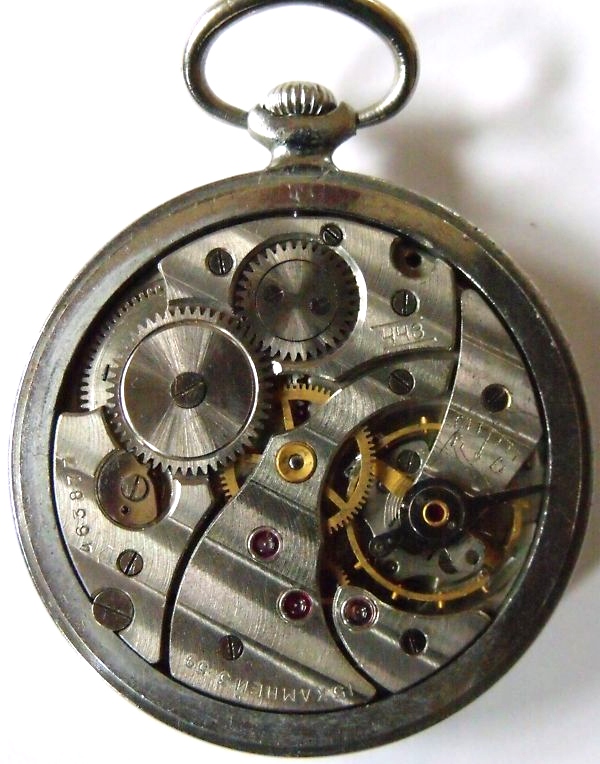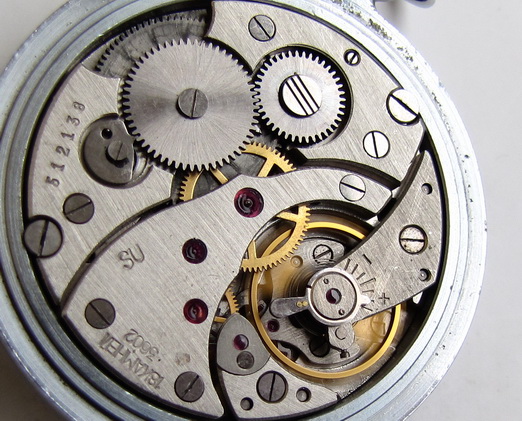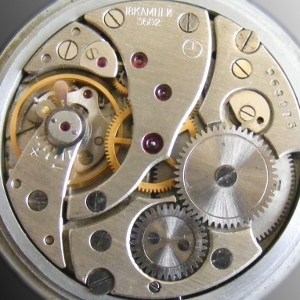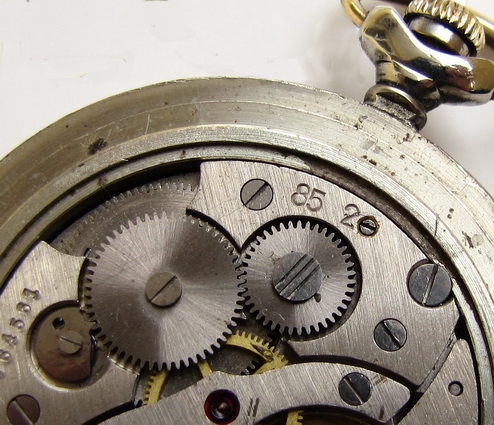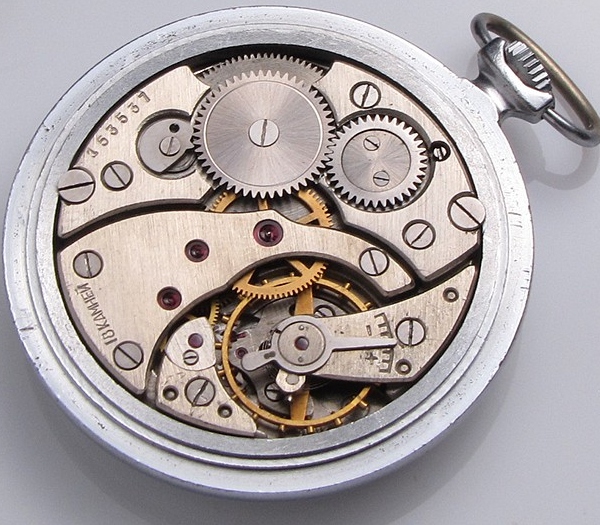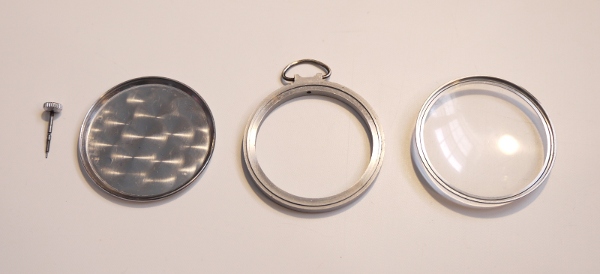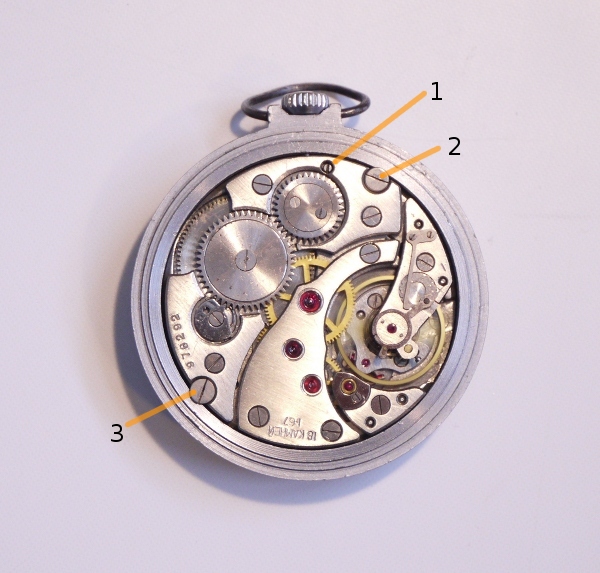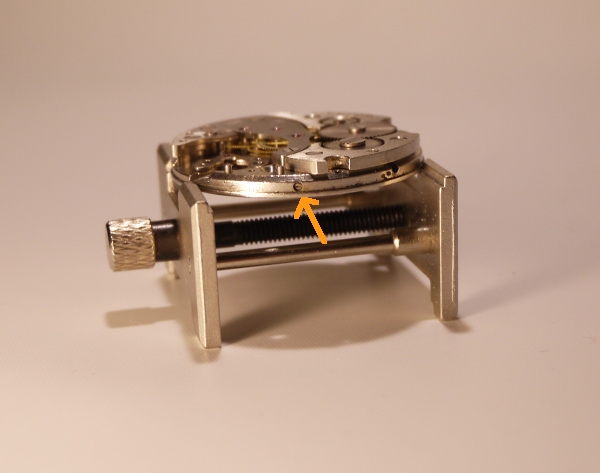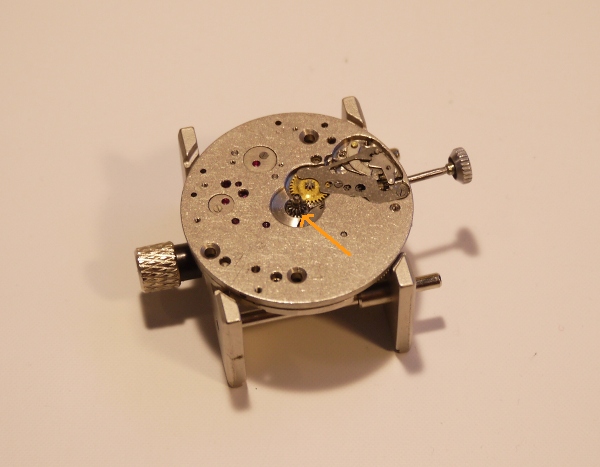내가 가지고 있는 뒷면에 늑대 두마리가 그려진 회중시계 ...
구소련마크가 있는 molnia회중시계에 대해 알아보려고 맘먹고 인터넷을 뒤졌
다...그리고 마침내 찾았다...
Molnija pocket watches
I have started this page because I like pocket watches. Russian Molnija watches are robust, good quality watches and are still available second hand. I don't speak or read Russian and I have no personal relation with the Molnija watches. This page is an assembly of pieces of information that I have found over time. 
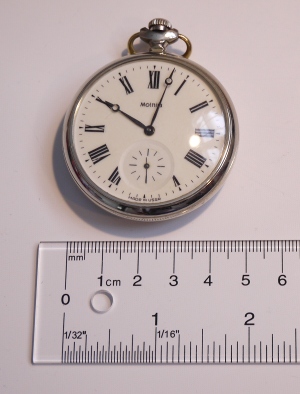

Why pocket watches?
I never really liked wrist watches and I used to carry my wrist watch in the pocket or I would just not carry any watch at all. I retired my watch when small GSM mobile phones came up. All the phones had a built in clock. I had no more need for an extra watch. Today smart phones are so big that they restrain you when carried in your pant's pocket. Now I avoid smart phones and wrist watches in my spare time. I find it as well good to do something together with my kids and be not reachable at all by phone. Thus I have re-discovered the good old mechanical watch.
As an engineer I find mechanical watches interesting from a technical point of view and we start with that aspect.
The Molnija mechanical movement
Molnija (Молния) pocket watches were made from 1941 to November 2007. The main factory was located in the Ural town of Chelyabinsk with a second factory outside of Moscow. The Russian word Молния means lightning.
The word "Молния" is pronounced like the English letter combination "Molnya".
A communist society does not have the concept of competition between rival companies. Thus there is no need to innovate a lot and re-design all the time. This can be very bad for the advancement of technology when it evolves still a lot. Cars and computers did e.g go through massive changes between 1941 to 2007. Mechanical watch movement did however have the time of new technology and innovation much earlier. By 1941 is was pretty much known how to design a good mechanical watch (the famous Waltham Watch Company stopped production in 1949).
The Molnija movement is a copy of a Cortebert movement as used in Rolex watches from around 1940 and they kept pretty much the same movement design until 2007 with just minor changes. Rolex sourced at the time the movements from the Swiss watch movement manufacturer Cortébert. Thus the Molnija movement was originally a Swiss Cortébert movement. A high quality movement. 

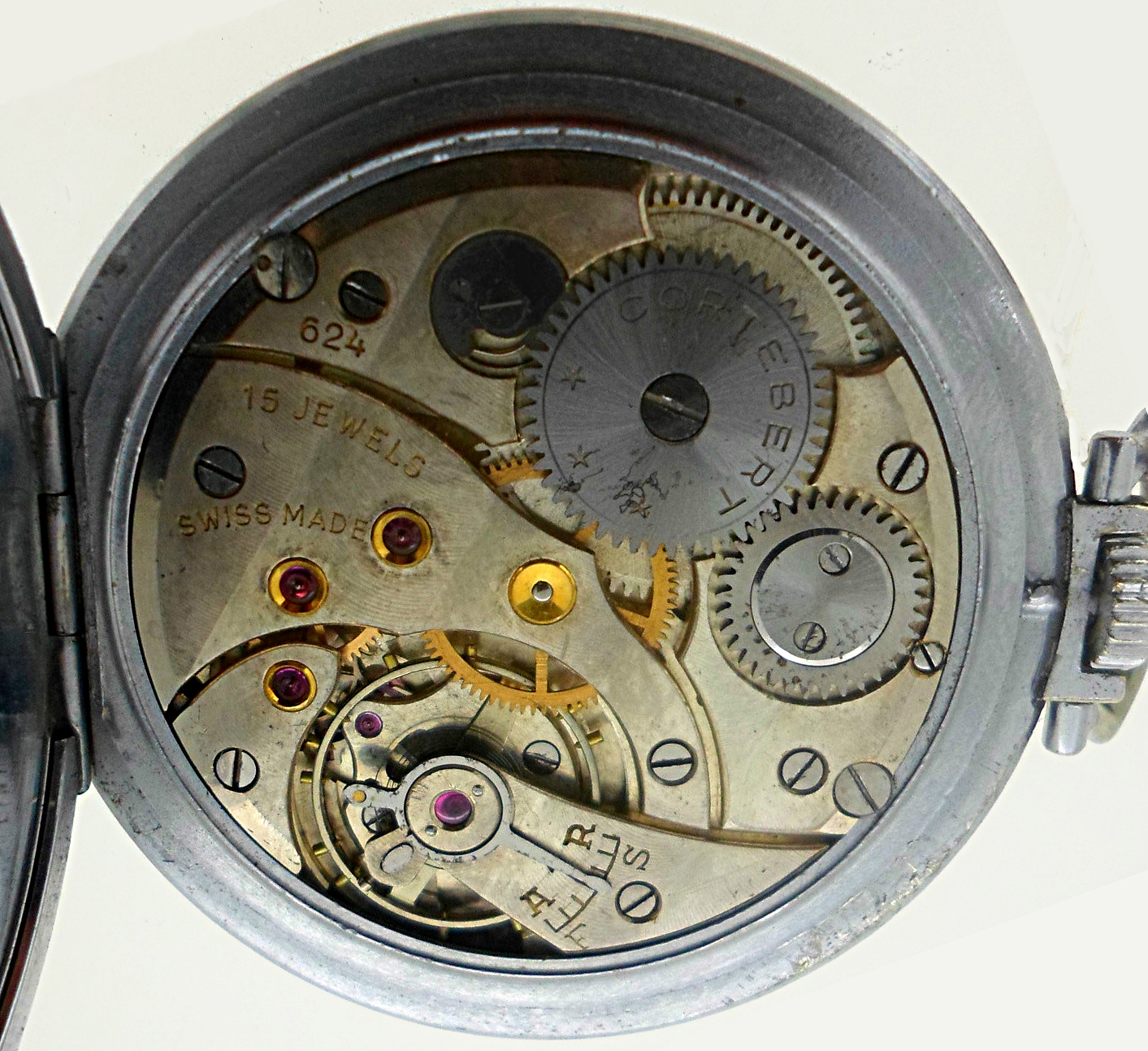
From left to right: a 1940's Rolex movement, an old Molnija 15j movement, a Cortebert 624 movement
This swiss movement design was very popular and a blue print for many movement designs from that time. Here is a 1947 Bulova watch movement: 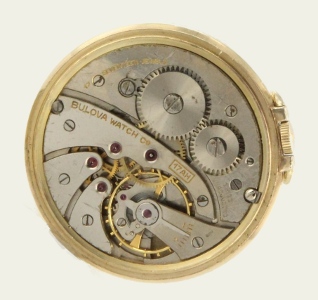
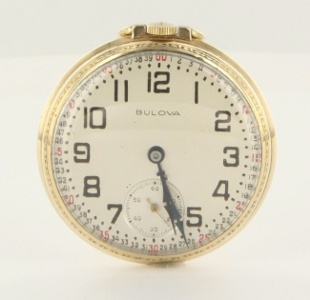
A 1947 bulova pocket watch
The fact that the Molnija movement changed very little over time does of course not mean that all Molnija watches were the same from 1947 to 2007. Even a communist society had a demand for more individual and different pocket watches and they changed them externally. There are many different cases and dials. They changed as well the movements and you can not easily mix spare parts from different Molnija generations but overall the changes made to the movements where minor.
The Molnija movement is a good, robust and reliable mechanical movement. An advantage of having very similar movements in all Molnija watches from today's point of view is that it is not difficult to find spare parts.
The movement is mainly made out of a nickel copper alloy. The smaller and more delicate cog wheels are made of brass and the bigger wheels which are directly connected to the main spring are made out of carbon steel.
Russian words and symbols on Molnija watch dials
- Молния -- Molnija.
- сделано в CCCP -- means Made in CCCP (Soviet Union).
- CCCP is Russian (Cyrillic) for Союз Советских Социалистических Республик -- it's the abbreviation for Soviet Union (Union of Soviet Socialist Republics).
 the little red symbol with CCCP on top of the letter "K" is official soviet mark for the certification of quality (see http://en.wikipedia.org/wiki/State_Quality_Mark_of_the_USSR). The symbol with the K on the side and CCCP on top can be seen in the middle of the dial. The Russian word for quality is "качество" thus the letter "K" in the symbol. This CCCP quality stamp means as well that this particular watch was made between 1967 and 1991 (that's the time period where those symbols where assigned to products by the State Attestation Commission).
the little red symbol with CCCP on top of the letter "K" is official soviet mark for the certification of quality (see http://en.wikipedia.org/wiki/State_Quality_Mark_of_the_USSR). The symbol with the K on the side and CCCP on top can be seen in the middle of the dial. The Russian word for quality is "качество" thus the letter "K" in the symbol. This CCCP quality stamp means as well that this particular watch was made between 1967 and 1991 (that's the time period where those symbols where assigned to products by the State Attestation Commission).
- Russian railroad style watches have this "winged wheel" symbol on the dial and a train on the back. Note that those are watches with standard movements. They were not more accurate than any other Molnija watch.
A watch that does not have any cyrillic letters on the dial was made for export.
Markings on Molnija watch movements
One or more of the following markings can be found on Molnija movements
- "ЧЧЗ" or "Ч2З". A lot of people will read this as 443 or 423. It's however not a number. "ЧЧЗ" is an abbreviation for "Челябинский Часовой Завод" and means Chelyabinsk Watch Factory. "Ч2З" is an acronym for "2nd Watch Factory" and it was located outside Moscow.
 The Chelyabinsk Watch Factory used in the 60's and later sometimes this symbol of a watch showing 9 o'clock.
The Chelyabinsk Watch Factory used in the 60's and later sometimes this symbol of a watch showing 9 o'clock.
- The amount of jewels (ruby stones bearings, камней). It seems possible numbers for Molnija pocket watches are 15, 17 and 18. Early Molnija watches had 15 jewels and the most recent watches had 18 jewels.
- A serial number. It seems that this number was frequently reset to some value. It's not exactly clear what tiggered the reset of the serial number and how it was really used. It is possible that a new 5 year plan, which changed about every 3 years, might have triggered the reset of the number. Communists have this notion of a 5 year plan were they set targets for the next 5 years such as e.g production volume targets. Thus the number was reset every 3-5 years and it might have been just a counter for the amount of units produced within a planing interval.
- Caliber or movement type. Molnia watches did at the beginning not have a caliber system to identify the movement. Early Molnija movements with 15 jewels have an abbreviation stamp that looks like "4K-6" and stands for "Часы Карманные - 6" which means "Watch Pocket - 6". The caliber system came up in the early 60th. The pocket watches movements have a diameter of 36mm and the first two digits in the Russian caliber system are equal to the diameter. The other two digits define the type of movement. The Molnia pocket watches were available in the following caliber: 3602=small second and without shock protection, 3603=small second and with shock protection, 3608=central second and without shock protection. "ЧК-6" is sometimes incorrectly referred to as caliber 3601 by people who think that 3601 was the model before 3602 but there was never a 3601 pocket watch movement. Almost all pocket watches are either "ЧК-6" or 3602 caliber movements.
- A date code in the form of "year quarter" or "quarter-year" and the year was written with just 2 digits (e.g 3-67 meant third quarter 1967).
- SU for country of production, Sovjet Union.
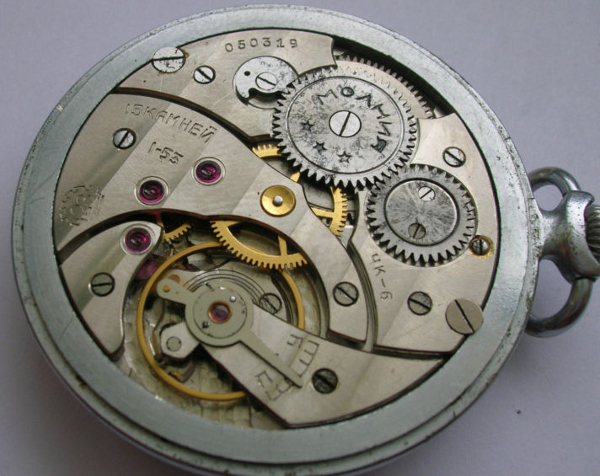
15 jewels, 1st quarter 1953, factory code "Ч2З" (Moscow), caliber "ЧК-6", serial number.
Note as well the very nice high quality surface finish only found in early molnija models.
Finding the age of a Molnija watch
It is of course interesting to find out what the age of a given Molnija pocket watch is. In case of many western watches the serial number can be used to determine the age. This is not the case for the Molnija. It seems they did frequently reset the serial numbers and I have not found a list of number ranges for a given year.
The situation is clear in the cases where we have a date stamp on the movement. As you saw in the above pictures there are cases where the movement has no date stamp. In those cases you can estimate the age from the number of jewels and in general the amount of markings:
- Molnija pocket watch movements have from 1947 to 1960 normally 15 jewels.
- Molnija pocket watch movements have from 1955 to 1960 either 15 or 17 jewels.
- Molnija pocket watch movements had from 1965 to 2007 normally 18 jewels.
- Early Molnija pocket movements do normally have date codes and are nicely finshed. Recent movements did no longer have date codes nor had they factory codes.
- Watches made shortly before the closure of the factory had very rough / unpolished parts.
Molnija pocket watch cases
US and Swiss pocket watch are often made from precious or precious looking materials such as gold filled copper cases, silver cases or silveroid/silverine (looks exactly like silver but is an alloy made copper, nickerl and zinc, also known as German silver).
Early Molnija cases are all made of steel with a layer of chrome or a nickel-copper alloy on top. Thus Molnija cases are less precious but as well more robust. Later models have a silverine back cover and steel case or have cases made completely from silverine.
The Russian caliber/calibre system
The caliber of a watch movement is not referring to the diameter of a movement. It describes the type of movement. The Russian caliber system came up in the early 60th. All Molnija pocket watch movements have a diameter of 36mm. The first two digits in the caliber system are the diameter (xx in the below table).
XX00 without second, without shock protection XX01 without second, with shock protection XX02 small second, without shock protection XX03 small second, with shock protection XX04 small second, date, without shock protection XX05 small second, date, with shock protection XX08 central second, without shock protection XX09 central second, shock protection XX10 central second, shock protection, anti-magnetic XX12 central second, shock protection, alarm XX14 central second, date, shock protection XX15 central second, shock protection, automatic XX16 central second, date, shock protection, automatic XX17 small second, without shock protection, chronograph XX23 central second, shock protection, 24 hours XX24 central second, shock protection, automatic, 24 hours XX27 central second, day-date, shock protection, automatic XX28 central second, day-date, shock protection XX31 central second, date, shock protection, automatic, 24 hours XX32 central second, date, shock protection, automatic, day/night-indicator XX33 small second, date, shock protection, chronograph XX34 central second, with/without shock protection, stop-second XX35 open balance XX35 central second, date, shock protection, automatic, day/night-indicator XX82 stopwatch XX95 additional stopwatch
Shock protection for a mechanical watch indicates that the delicate pivots that hold the balance wheel are mounted in a spring suspension system. A shock resistant watch is supposed to survive falling from a height of 1 meter onto a horizontal hardwood surface without any damage to the balance wheel staffs.
Most of the Molnija pocket watches are caliber 3602. Shock protection is very useful for wrist watches and rarely used for pocket watches. A few pocket watch models in the late 80s and 90s were caliber 3603.
Older Molnija watches made before the introduction of the general Russian caliber system had caliber "ЧК-6" which is functionally similar to 3602. Components of the older "ЧК-6" are however not necessarily interchangeable with 3602 due to minor differences in form and dimension.
Molnija pocket watches made for export
A Molnija pocket watch with the the words "MADE IN USSR" at the bottom of the dial was produced for export only.
Those "export molnija" watches had inside most of the time the same 3602 movements as for the home market (with markings in Russian). The below watch is special because it's completely "English", outside at the bottom of the dial and inside. It's an interesting watch because it has a 3603 movement (with shock protection for the sensitive balance staffs). You can see that the bearings of the balance wheel look different.
We know that molnija watches made in the years just before the closure of the factory (year 2000 and up) had nice designs on the outside but where technically poorly done with rough surfaces, simplifications like no central ruby stone, almost no markings on the movement. In other words the below watch was definitely made before 2000. I think that this watch might be from the late 80's or early 90's when they were still motivated to export good watches and not only fashion pieces. The fact that it has a special 3603 movement, when most watches used 3602, suggests that they wanted to produce a watch with good technology inside. 
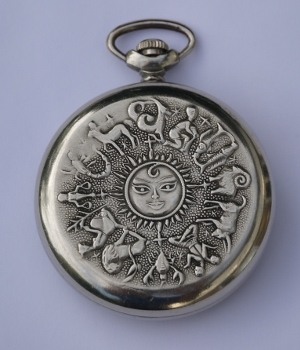
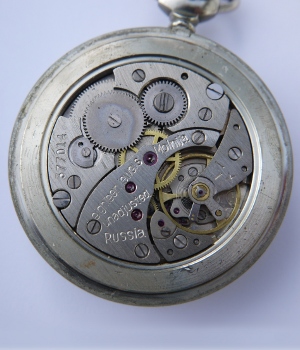
Molnija signs of zodiac, 3603 movement (shock protection), 18 jewels, markings all in English, plastic dial, silverine case
Another example of Molnija watches made for export where the Serkisof watches. Serkisof was an Istanbul-based jeweler, a family business. Serkisof imported those watches from Russia in sufficient numbers to be able to ask for small modifications to the style of the watch. Most of them where sold to the Turkish National Railways. The back of those watches said "Serkisof Demiryolu". Demiryolu is Turkish and means railway. The Serkisof watches are from the 70's and early 80's. The movement is an unmodified 3602 movement with markings in Russian (not English). Some of the Serkisof watches had an extra dust cover (visible when you open the back) and it was either a plain cover or it said "FIRST QUALITY, SERKISOF, GUARANTY" (in English) on the dust cover. 

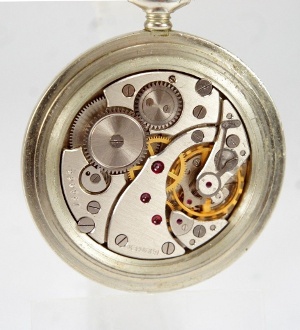
Molnija Serkisof, standard 3602 movement, 18 jewels
Note that those Molnija Serkisof railroad watches are not the same as american railroad watches. They did not have higher accuracy requirements. Those watches have ordinary Molnija movements.
Rubies
Ruby is a gemstone that is almost as hard as diamond. It consists of Al2O3 with some chromium (Cr3+) ions in the crystal. The chromium gives it the red color. Ruby does occur naturally but it is not too difficult to produce synthetic rubies. This made ruby an attractive material for durable low friction bearings in watches. Molnija watches have, dependent on the model, between 15 and 18 rubies.
How to open a Molnija pocket watch
Put a white linen sheet or white pillowcase on the table before you take a watch apart. This prevents small parts from bouncing around in case they are accidentally dropped.
All Molnija pocket watches have a "snap-in" case. That is: you need a case knife to open the front and the back. Near the top (where the crown is, at 11 o'clock or at 1 o'clock) should be a small gap between the case ring and the front / back. This is where you can carefully insert a case knife and open it. Don't apply too much force. It should open easily.
To remove the movement from the case you need to first take out the crown.
Pull the crown up and then loosen screw 1 a little bit, just a few turns (see below for more details). This will allow you to pull out the crown and stem. Remove the front (crystal with the metal ring around it) and then remove the two case screws 2, 3. The movement will come out towards the front.
Taking out the stem and crown
There is a small clutch wheel that is sliding over the stem in the opposite direction in which you pull the stem. If you remove the stem the wrong way then you might end up in a situation where it becomes difficult or even impossible to put it back without taking the watch apart.
Taking it out:
- Pull the crown out into the position where you would normally set the time. Remember how far out it is.
- Unscrew the little screw on the back about 3-5 turns and push it in with the screw driver. The stem should now come out easily.
Putting it back in:
- Put a tiny drop of oil onto the stem.
- Hold the watch face down and insert the stem to the same position that you remembered before.
- Tighten the screw gently by 1-2 turns and then move the stem slightly up and down to check if it has snapped-in properly. This little screw controls a nose which needs to go into a groove on the stem.
- Tighten the little screw a bit more (gently). Push the stem in all the way once you are sure that the nose controlled by the screw snapped-in properly.
- Test it.
Removing the hands of a watch
Normally one needs a special tool to pull the watch hands. However if you just repair watches once in a while then it's not worth it to buy all kinds of special equipment. To pull out the watch hands with your finger nails is not a good idea as you can easily hurt yourself or bend the watch hands. To use a screw driver does more damage than good.
What works well is a prybar type of watch hands remover:
To use this watch hands remover you cut a v-shape out of a piece of paper. You discard the V and slide the remaining paper below the watch hands to protect the dial against scratches. You insert the small prybars at the axis below the hour hand and then you push them both at the same time carefully down. The watch hands will just pop up. You can put a transparent plastic bag on top of the watch hands while you do this. This will prevent the watch hands from flying around when they come off.
To make these prybars you take a thick copper wire and you cut 2 pieces off. You bang with a hammer onto the wire ends until they are flat. After that you take a file and you make the ends thin enough such that the can be inserted between dial and hour hand. Finally you use needle nose pliers to bend the ends as shown in the above picture.
Brass wire (as used for welding) can as well be used. It should always be a metal that is not magnetic.
Removing and cleaning the dial
It's not obvious at first how the dial is mounted on the watch. There are 2 small screws on the side of the movement. one between 4 and 5 o'clock and one between 10 and 11 o'clock. Those have to be turned loose a few turns and then the dial can be taken off. Obviously the hands for the hour, minutes and seconds have to be removed first.
Not all Molnija dials can be cleaned. New dials are sometimes out of plastic and they can be washed with a bit of soap. Older dials are silver coated metal plates painted with a white, semi transparent paint. Those dials can not be cleaned. Any cleaning or washing will normally damage the dial and make things worse. You should as well avoid touching the dial with your fingers as salts and acids on the skin will show up as finger-prints after a while.
Cleaning and oiling a watch
 SAE 0W20 syntetic racing oil in a 50ml bottle and Moebius 9010 in the original bottle. |
There are lots of resources on youtube.com, blogs (e.g http://dcwatches.blogspot.ca/2011/08/russian-molnija-3602-pocket-watch.html, http://watchguy.co.uk/russian-molnija-pocket-watch-part-1/) and home pages that describe how to take a Molnija apart. I will therefore not cover this part here. I do recommend to get a set of quality screw drivers, good tweezers and it is a good idea to watch a number of Molnija watch repair videos or read some blogs about Molnija pocket watches before you even start.
There are sometimes passionate discussions about the right watch oil. Moebius 9010 is something that a lot of people recommend but I think the whole discussion about oil is really over rated. There are cheaper alternatives that are as good. Watches are normally operated at temperatures between 20'C and 36'C and they run rather slow. Not very tough conditions. Watch oil must however fulfill the following requirements:
- It must be a thin oil that does not spread.
- It must not gum-up. Thus it should consist of molecules of similar length only (synthetic oil).
- It must not be plant based (no canola oil). Plant based oils contain many different molecules and oleic acids that can react with metal.
- It must not degrade (evaporate or oxidize). Any oil evaporates slowly over time even at room temperature but a small drop should stay for decades. Oil can react with the oxygen in the air and watch oil should not do that easily. Synthetic oils are all very stable and are not expected to oxidize, polymerize or volatilize at room temperature for at least 10 years.
A thin synthetic motor oil (racing oil) such as SAE 0W20 or SAE 0W10 will easily fulfill the above requirements and you can get a full liter of oil for half the price of 2ml Moebius 9010. The viscosity around 25'C is roughly the same. You will only need a few tiny drops and you can use the rest in your car.
An easy way to apply a small drop of oil is to use a thin but solid copper wire and dip it in oil. A tiny drop forms at the tip of the wire when you take it out of the oil and then you just touch with the wire the point where you want to apply oil.
 The drawing shows the very thin balance staffs sitting in the caped balance wheel jewels (red) with a thin film of oil (blue). The staffs glide on this thin film of oil amost frication free. |
The most difficult to oil parts of a mechanical watch are the balance staffs. This is unfortunately as well the most important part. The balance staffs are very thin "needles" at the end of the balance wheel axis. They have typically a diameter of 0.1mm and are barely visible with the naked eye. The balance wheel rubies are caped. That is: they are closed at the end and you have to take the balance wheel out to apply oil. You can not oil this part from outside while the watch is still assembled.
I was very nervous when I took for the first time a balance wheel out of a pocket watch but now it is almost a routine job. It is not difficult. The main thing to remember is: Do not force it! It will go out and back in easily if it is in the right position. When you put it back in you just place it approximately in the right position and then push it gently with a tooth pick until the staffs find the holes in the ruby stones. The wheel will start spinning once it is in the right position. You fasten the screw on the balance cock only once you are sure that everything is working.
A tiny drop of oil needs to be between the balance staff and the rubies. The staffs glide on this film of oil. Too little oil damages the balance staffs over time. Too much oil will climb up the balance wheel axis and the viscosity of all that oil will damper the oscillation of the balance. The watch will become unreliable when there is too much oil or too little oil. The drawing on the right shows a balance staff sitting in the ruby stone with the right amount of oil shown in blue.
It's difficult to get oil into the ruby on the balance cock (the bridge at the top of the balance) because the hair spring is attached to the balance cock. I find that a very thin hollow needle oiler works best in this case because you must not get any oil onto the hair spring. You clean the oiler needle from outside with a paper such that it is dry. This will prevent oil to get onto the hair spring in case you touch the hair spring accidently with the sides of the oiler needle. Place the balance wheel on the table with the balance cock facing the table. Pull the balance wheel up such that the hair spring extends a bit. Now you can reach the ruby hole through the spaces between the hair spring without touching the hair spring. If you apply accidentally too much oil then just take a small stripe of paper and let the excess oil soak into the paper.
It's enough to clean and oil a watch every 5-10 years.
Molnija pocket watch accuracy
Don't compare the accuracy of old mechanical movements with modern quartz watches. Those old mechanical watches where made when people would tell the time in increments of 5 minutes.
Molnijas are said to be rated with an accuracy of -20 to +40 seconds a day. The precision of a mechanical watch depends very much on the environment it is used in. The good thing about mechanical watches is that you have to wind them every day and you can use that moment when you wind the watch to check the time and set the correct time in case the watch it too far off.
A pocket watch will in general run faster if it is just sitting on your desk at a constant room temperature of 21'C [70'F]. It will normally run slower if it is in your pocket at 33'C [92'F] and being shaken a bit. The difference between "steady desk" and "moving warm pocket" could be up to 20sec a day. Thus you should use a watch while you calibrate it.
A well maintained and clean Molnija pocket watch can be calibrated to your usage pattern and be within 15sec accuracy per day.
If you clean a watch and the watch runs after the cleaning a lot faster then check the hair spring on the balance wheel. There might be a tiny amount of oil or dirt somewhere on the spring. Even if the spring coils do not permanently stick together they might do so temporarily while contracting and expanding. The hair spring should always be totally clean and dry. A similar problem appears when you accidentally magnetize the hair spring coil with a magnetic screw driver. Never get too close to the hair spring with a screw driver.
A watch that is running much too slow despite everything cleaned and oiled might have a bent or damaged balance staff or a damaged jewel. There is as well the possibility that the cog wheel for the minute hand is sitting too lose on its axis. This cog wheel is not permanently attached otherwise one would not be able to set the watch. The cog wheel is called the cannon pinion. The cannon pinion is attached with a friction fit. The friction between the axis and the cannon pinion has to be much higher than the friction caused by the cog wheel used for setting the time and to move the hour hand (motion work).
Tightening the cannon pinion
You should avoid to take off the cannon pinion when you clean and oil a watch unless you suspect there is a problem. This is a small cog wheel that sits on the axis in the center of your watch and the minutes hand is attached to it.
The cannon pinion is attached with a friction fit. If you take it off, oil it and put it back on then you will reduce the amount of friction and the watch may stop working.
A watch that is several minutes slow per day and the amount of minutes change in an erratic way from day to day may have a loose cannon pinion. A typical example would be a watch that is one day 5 minutes slow and the next day 9 minutes slow. If the cannon pinion is very loose then you will see that the watch is ticking, the seconds hand is moving but the minutes hand does not move.
Normally you need special pliers to tighten the cannon pinion. If you are however an occasional "weekend watchmaker" then it's a problem to buy all those tools. Here is a cannon pinion tightening tool that works well and you can build it yourself. You need a small steel metal sheet, 0.6mm to 0.8mm thick and you cut a slot into it using an iron saw with a fine blade. This cannon pinion tightener can be seen in the photos below. You slide the cannon pinion into that slot and you tap with a hammer gently onto the top of the cannon pinion tightener such that the middle of cannon pinion is compressed. When you think that you did compress it enough then you turn the cannon pinion by 90 degree and you compress it again. Be careful to not make it too tight. You can mark one tooth of the canon pinion with a felt tip marker such that you know which sides you have compressed. This way you can test it in the watch and put it back into the cannon pinion tightener with the same orientation in case it is still too lose.

You tap with a small hammer on top of the self made cannon pinion tightener to tigthen the cannon pinion. Don't hit too hard!
Buying a Molnija on ebay
Some people list watches as "excellent condition, working" just after winding them and checking for a moment that they are ticking. That may be an acceptable test for a quartz watch but mechanical watches are complicated devices and can't be checked like that.
I do usually ask the seller to run the watch for 24h face up and then check the time. After that the seller should run the watch for 24h face down and check the time again. The differences between face up and face down must be within 10sec. The watch should not be off for more than 1-2min after 24h. This is not a perfect test but there is a good chance that the watch is not worn out and does not have a mechanical defect if the test passes.
Buying a Molnija at an antiques store or at a flea market
Here are a few suggestions for things that you can check when you buy the watch in person.
- Inspect the watch visually for damage.
- Change the time and check if need always the same amount of force to move the hands no matter what time you set.
- Wind it.
- Listen to it.
A good watch has a sharp metallic sound and it does not change when you turn it. A dull click-click or a scratching sound is an indication of a possibly severe mechanical problem.
Here is how a good molnija pocket watch sounds:
Corrections and suggestions
Write me if you have some thoughts about Molnija pocket watches. You can contact me at: guidosocher@fastmail.fm
Links
- http://en.wikipedia.org/wiki/Mechanical_watch
- http://en.wikipedia.org/wiki/Molnija
- http://en.wikipedia.org/wiki/Movement_(clockwork)
- http://en.wikipedia.org/wiki/Cortebert_(watch_manufacturer)
'이런저런 잡설' 카테고리의 다른 글
| 독버섯에대한 잡설 (0) | 2014.09.22 |
|---|---|
| 독버섯의 독성분과 중독증상에 대한 잡설 (0) | 2014.09.22 |
| 제주 돌하루방 아버지 벅수 알아여? (1) | 2014.08.11 |
| 今臣戰船尙有十二 (0) | 2014.08.05 |
| Why? 왜수군은 대함대를 끌고 좁고 험한 명량으로 들어온걸까? (0) | 2014.08.04 |


